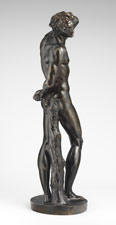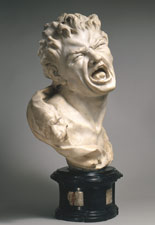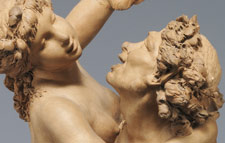New Connections appear every Wednesday. Sign up for a reminder.
Curator of European sculpture and decorative arts Ian Wardropper on the profound relationship between touch and sculpture.
 1280852
1280852 1280991
1280991 1280891
1280891 7981024
7981024 8101024
8101024 8681024
8681024 5851024
5851024 11461024
11461024 5301024
5301024 5301024
5301024 5301024
5301024 7271024
7271024 6941024
6941024 1280910
1280910 8801024
8801024 7131024
7131024 7051024
7051024 1280586
1280586 8371024
8371024 9881024
9881024 8791024
8791024 6231024
6231024 6801024
6801024 12801021
12801021 8141024
8141024 1280813
1280813 1192826
1192826 1280852
1280852
My name is Ian Wardropper, I'm curator of European sculpture and decorative arts, and my topic is touch.
Museums privilege sight. We let people look, but we discourage people from touching.
I find that using my sense of touch becomes another means of perceiving objects.
Touching something, someone, hugging someone creates an emotional response, and so touching a work of art, I think, does also unleash certain emotions in a way that might be purely abstract if you're only using your eyes.
And it's a pity that we don't allow the general public to do that, but if we let everybody touch
the acids in people's sweat would bite into metal, rings on their fingers would scratch objects and there'd
be nothing left. For that reason, the only ring I wear is my wedding ring out of love for my wife. We don't let people touch for good reason, but it fascinates me what that means.
There are certain kinds of sculpture which are meant to be held in the hand. So you are invited to touch it and to move it. You feel
the smoothness of the skin. One pose flows into another—from some angle it might seem a little bit more angular
from another it's an incredibly suave, swaying pose. We all use touch as a kind of diagnostic tool.
If you go into a clothing store, you are drawn to use your hand to assess the weight of the cloth, is it as pleasing to the touch as it looks?
So when I'm examining a work of art, I'm often looking for, so to speak, certain kinds of traits, which I can only appreciate through feeling.
If you pick up a bronze sculpture, if it's light, that may mean that it's later in date. Technologically they were able to make thinner-walled sculpture more perfectly later. I might pick up
a silver object and just judge the sheer amount of metal that went into it. Silver is inherently mercantile and the amount of silver in it means how valuable it is. But it's also about
balance—picking up two handles, was it perfectly balanced so that it feels right in the hands?
A marble statue might have had old plaster repairs that might not be immediately visible to the eye, but are
to the touch, because the marble would be cooler, the plaster would be slightly warmer.
I've had some of the most revealing and profound moments exploring a work of art with somebody who's visually impaired. That person is appreciating through keenly developed sense of touch.
Recently I went to examine a few works in our galleries with somebody who was blind. In looking at
a Pope in bronze, the blind person might immediately, for example, go to the nose to appreciate the character of the person, and understand their age from running her hand over the face. But there are always also these astonishing insights.
She said, "Well, he must be sitting down." And I said, "Why is that?" And she said, "Well, feel the belly: His weight is in such a way, his shoulders back slightly. It feels to me as if he's sitting down." Which is not something that ever occurred to me to ask myself when I was looking at the Pope. So there's this kind of logic, which is fascinating.
Touch is, through texture, one of the ways a sculptor uses different kinds of material in making an artistic statement, so
at the moment that you're looking at Gian Lorenzo Bernini's Faun Teased By Children, I think you also feel the differences between the different forms, so that the highly
polished body of the satyr is meant to play off the deliberately roughened surface of the bark of the tree that he's straddling.
Often the traces of the making of works of art disappear in the final product, but if you look closely at terracotta
you can see fingerprints, you can see the smudging of the fingerprints to create a texture, that he's taken his fingernail and made a slight little crease. You see the sense of touch, it's created this work.
And if you hold it, you feel an identity with the artist because your hand is in the same place where his was. But when you put all your senses together
you have the full appreciation of a work of art.
 |
 |
 |
 |
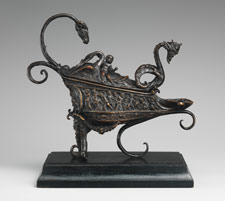 |
 |
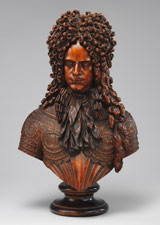 |
 |
 |
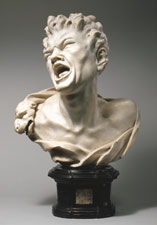 |
 |
 |
 |
 |
 |
Works of art in order of appearanceLast Updated: June 22, 2015. Not all works of art in the Museum's collection may be on view on a particular day. For the most accurate location information, please check this page on the day of your visit. |
||
 |
Cabinet with personifications of the Five Senses third quarter of 17th century English Satin worked with silk and metal thread, purl, chenille, seed pearls, coral beads, and mica; tent knots, rococo, satin, couching, and detached buttonhole stitches, knots; woven metal thread trim; silk and paper lining Rogers Fund, by exchange, 1929 (29.23.1) More information: The Collection Online Not on view
|
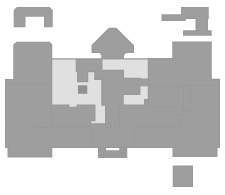 European Sculpture and Decorative ArtsFirst Floor
European Sculpture and Decorative ArtsFirst Floor |
 |
Pygmalion and Galatea ca. 1890 Jean-Léon Gérôme (French) Oil on canvas Gift of Louis C. Raegner, 1927 (27.200) More information: The Collection Online Not on view
|
 European PaintingsSecond Floor
European PaintingsSecond Floor |
 |
A Hypocrite and Slanderer ca. 1770–83 Franz Xaver Messerschmidt (Austrian) Tin alloy Purchase, European Sculpture and Decorative Arts Fund; Lila Acheson Wallace, Mr. and Mrs. Mark Fisch, and Mr. and Mrs. Frank E. Richardson Gifts, 2010 (2010.24) More information: The Collection Online Not on view
|
 European Sculpture and Decorative ArtsFirst Floor
European Sculpture and Decorative ArtsFirst Floor |
 |
Torso of a Ptolemaic King Ptolemaic Period, 80–30 b.c. Egyptian Dark basalt Purchase, Lila Acheson Wallace Gift and Rogers Fund, 1981 (1981.224.1) More information: The Collection Online Not on view
|
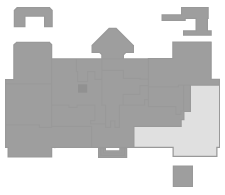 Egyptian ArtFirst Floor
Egyptian ArtFirst Floor |
 |
Oil lamp with friezes of playing children ca. 1515 Andrea Briosco, called Riccio (Italian) Bronze European Sculpture and Decorative Arts Fund, 2009 (2009.58) More information: The Collection Online Not on view
|
 European Sculpture and Decorative ArtsFirst Floor
European Sculpture and Decorative ArtsFirst Floor |
 |
Saint Sebastian 1566 Alessandro Vittoria (Alessandro Vittoria di Vigilio della Volpa) (Italian) Bronze Samuel D. Lee Fund, 1940 (40.24) More information: The Collection Online Not on view
|
 European Sculpture and Decorative ArtsFirst Floor
European Sculpture and Decorative ArtsFirst Floor |
 |
Bust of Alexander Menshikov (ca. 1670–1729) ca. 1703–4 Swiss, Austrian, or German artist (active Russia) Red pine (pinus sylvestris), wrought iron Wrightsman Fund, 1996 (1996.7) More information: The Collection Online Not on view
|
 European Sculpture and Decorative ArtsFirst Floor
European Sculpture and Decorative ArtsFirst Floor |
 |
Paris ca. 1500 Antico (Pier Jacopo Alari Bonacolsi) (Italian) Bronze, partly gilt and silvered Edith Perry Chapman Fund, 1955 (55.93) More information: The Collection Online Not on view
|
 European Sculpture and Decorative ArtsFirst Floor
European Sculpture and Decorative ArtsFirst Floor |
 |
Pair of wine coolers marked 1781 Ignaz Josef Würth (Austrian) Silver Purchase, Anna-Maria and Stephen Kellen Foundation Gift, 2002 (2002.265.1a,b,.2a) More information: The Collection Online Not on view
|
 European Sculpture and Decorative ArtsFirst Floor
European Sculpture and Decorative ArtsFirst Floor |
 |
Bust of Marsyas ca. 1680–85 Balthasar Permoser (German) Marble, ebony socle inlaid with marble Purchase, Rogers Fund and Harris Brisbane Dick Fund, 2002 (2002.468) More information: The Collection Online Not on view
|
 European Sculpture and Decorative ArtsFirst Floor
European Sculpture and Decorative ArtsFirst Floor |
 |
Pair of eyes 5th century b.c. or later Probably Greek Bronze, marble, frit, quartz, and obsidian Purchase, Mr. and Mrs. Lewis B. Cullman Gift and Norbert Schimmel Bequest, 1991 (1991.11.3a, b) More information: The Collection Online Not on view
|
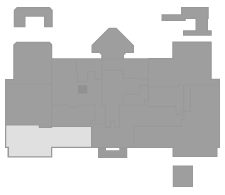 Greek and Roman ArtFirst Floor and Mezzanine
Greek and Roman ArtFirst Floor and Mezzanine |
 |
Belisarius and his Guide 1791 Antoine Denis Chaudet (French) Bronze Rogers Fund and Edith Perry Chapman Fund, 2004 (2004.113a, b) More information: The Collection Online Not on view
|
 European Sculpture and Decorative ArtsFirst Floor
European Sculpture and Decorative ArtsFirst Floor |
 |
Pope Innocent X, Giovanni Battista Pamphilj (1574–1655, r. 1644–1655) second half of 17th century After Alessandro Algardi (Italian) Bronze Rogers Fund, 1908 (08.49) More information: The Collection Online Not on view
|
 European Sculpture and Decorative ArtsFirst Floor
European Sculpture and Decorative ArtsFirst Floor |
 |
Bacchanal: A Faun Teased by Children 17th century (ca. 1616–17) Gian Lorenzo Bernini (Italian) Marble Purchase, The Annenberg Fund Inc. Gift, Fletcher, Rogers, and Louis V. Bell Funds, and Gift of J. Pierpont Morgan, by exchange, 1976 (1976.92) More information: The Collection Online Not on view
|
 European Sculpture and Decorative ArtsFirst Floor
European Sculpture and Decorative ArtsFirst Floor |
 |
Nymph and Satyr Carousing 18th century (ca. 1780–90) Clodion (Claude Michel) (French) French (Paris) Terracotta Bequest of Benjamin Altman, 1913 (14.40.687) More information: The Collection Online Not on view
|
 European Sculpture and Decorative ArtsFirst Floor
European Sculpture and Decorative ArtsFirst Floor |
© 2011 The Metropolitan Museum of Art |
||



